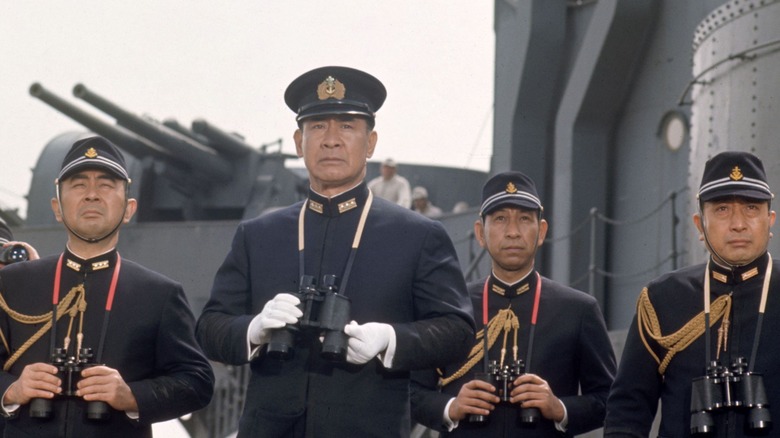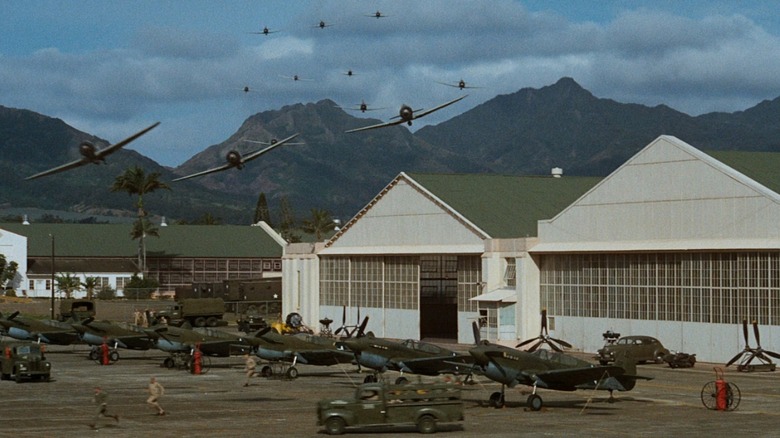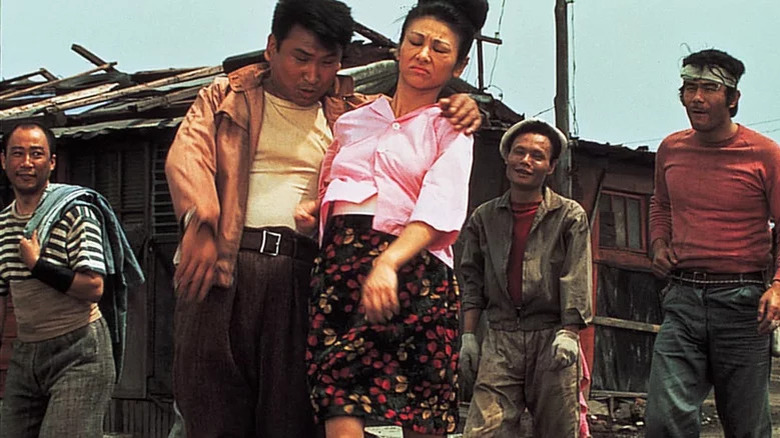Fox's Attempt To Recruit Akira Kurosawa Ended In Tragedy
The 1970 war epic "Tora! Tora! Tora!" takes place from August 1939 to December 1941, dramatizing the wartime events that led up to the attack on Pearl Harbor. The film alternately follows the American and the Japanese military during the same 29-month period, with the American sequences directed by Richard Fleischer and the Japanese sequences directed by Kinji Fukusaku (of "Battle Royale" fame) and Toshiro Masuda. 20th Century Fox ultra-producer Darryl F. Zanuck conceived of the project, as he wanted to give a proper telling of both sides of Pearl Harbor while also wanting to partially exonerate the American military (which had previously been blamed for its inability to prevent the attack).
Planning and shooting "Tora!" took an amazingly long amount of time. Pre-production wrangling lasted about three years, with principal photography taking an entire eight months. To make sure the Japanese segments would be handled by a master, Fox hired Akira Kurosawa to co-direct.
Kurosawa, however, was no director-for-hire. He was accustomed to shooting on his own schedules and with his own budgets and usual collaborators. In 1965, Kurosawa had a huge success with "Red Beard," but was already established as one of his generation's best filmmakers with films like "Rashomon," "Seven Samurai," "Ikiru," "Throne of Blood," "Yojimbo," and a large fistful of other stone-cold classics.
Working with Fox was terribly difficult. There were a lot of communication and budgeting issues that Kurosawa hated. What's more, the filmmaker wound up going through a well-documented emotional crisis that led to a deep, years-long depression that took many years for him to emerge from. Scott Eyman's book "20th Century-Fox Darryl F. Zanuck and the Creation of the Modern Film Studio" tells the story of how Kurosawa was hired and how he eventually left the project.
Kurosawa wasn't used to taking orders from studios
Kurosawa was only involved in "Tora! Tora! Tora!" for three weeks. According to Eyman's book, those three weeks produced no useable footage, much to the consternation of Fox, Zanuck, and Zanuck's son Richard, who also served as a producer. The stories from the time said that Kurosawa was being too much of a perfectionist, while Fox wasn't clear about whether or not he would have final cut on his sequences. Indeed, Kurosawa didn't like the idea of Fox's editors, whom he didn't know, tinkering with his work. He was smeared with accusations of being "difficult."
After visiting a neuropsychologist, Kurosawa was given leave and said to have been "suffering from disturbance of sleep, agitated with feelings of anxiety and in manic excitement ... It is necessary for him to have rest and medical treatment for more than two months." In response, Richard Zanuck flew to Japan and fired Kurosawa personally.
On the DVD commentary for "Tora! Tora! Tora!," Richard Fleischer explained that Kurosawa wasn't used to American studio oversight. Basically, he couldn't dive into the world of commercial American cinema, having earned his cultural stature. "Churning out" wasn't his métier. To quote Fleischer directly:
"I always thought that even though Kurosawa was a genius at filmmaking and indeed he was, I sincerely believe that he was miscast for this film, this was not his type of film to make, he never made anything like it and it just wasn't his style. I felt he was not only uncomfortable directing this kind of movie but also he wasn't used to having somebody tell him how he should make his film. He always had complete autonomy, and nobody would dare make a suggestion to Kurosawa about the budget, or shooting schedule, or anything like that."
Which is understandable.
The commercial failure of Kurosawa's Dodes'ka-den
It seems that Kurosawa was baffled and pressured by all the new studio stricture. He wanted to make "Tora! Tora! Tora!" work, but it was giving the filmmaker more and more anxiety. As Fleisher recalled:
"Darryl Zanuck [was] on his back, and Richard Zanuck [was] on him and Elmo Williams and the production managers, and it was all stuff that he never had run into before. Because he was always untouchable. I think he was getting more and more nervous and more insecure about how he was going to work on this film. And of course, the press got a hold of a lot of this unrest on the set and they made a lot out of that in Japan, and it was more pressure on him, and he wasn't used to that kind of pressure."
The anger and pressure forced Kurosawa out of the project. Instead, he went on to shoot 1970's "Dodes'ka-den," his first feature in color. In his book "Something Like an Autobiography," Kurosawa wrote that he made "Dodes'ka-den" to "prove I wasn't insane." He could indeed make a film in the way he liked and on a schedule he liked. Rather unfortunately, however, "Dodes'ka-den," although made for a small budget, lost money at the box office, proving to be Kurosawa's first legitimate bomb.
The failure of "Dodes'ka-den" compounded Kurosawa's depression and even led him to make an attempt on his own life. It took Kurosawa a long time to recover and even longer to return to filmmaking. In 1975, Kurosawa finally recovered by collaborating with a Soviet film studio called Mosfilm, which co-funded his next project, "Dersu Uzala." That (excellent) film was a hit and Kurosawa got a new lease on life.
He made five more films before his death in 1998.


